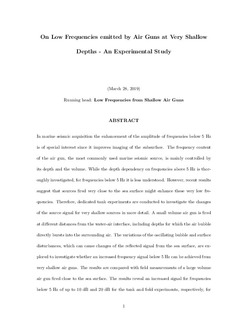| dc.contributor.author | Wehner, Daniel | |
| dc.contributor.author | Landrø, Martin | |
| dc.contributor.author | Amundsen, Lasse | |
| dc.date.accessioned | 2019-10-23T15:03:59Z | |
| dc.date.available | 2019-10-23T15:03:59Z | |
| dc.date.created | 2019-08-08T11:45:25Z | |
| dc.date.issued | 2019 | |
| dc.identifier.citation | Geophysics. 2019, 84 (5), P61-P71. | nb_NO |
| dc.identifier.issn | 0016-8033 | |
| dc.identifier.uri | http://hdl.handle.net/11250/2624017 | |
| dc.description.abstract | In marine seismic acquisition, the enhancement of frequency amplitudes below 5 Hz is of special interest because it improves imaging of the subsurface. The frequency content of the air gun, the most commonly used marine seismic source, is mainly controlled by its depth and the volume. Although the depth dependency on frequencies greater than 5 Hz has been thoroughly investigated, for frequencies less than 5 Hz it is less understood. However, recent results suggest that sources fired very close to the sea surface might enhance these very low frequencies. Therefore, we conduct dedicated tank experiments to investigate the changes of the source signal for very shallow sources in more detail. A small-volume air gun is fired at different distances from the water-air interface, including depths for which the air bubble bursts directly into the surrounding air. The variations of the oscillating bubble and surface disturbances, which can cause changes of the reflected signal from the sea surface, are explored to determine whether an increased frequency signal below 5 Hz can be achieved from very shallow air guns. The results are compared with field measurements of a large-volume air gun fired close to the sea surface. The results reveal an increased signal for frequencies below 5 Hz of up to 10 and 20 dB for the tank and field experiments, respectively, for the source depth at which the air gun bubble bursts directly into the surrounding air. For large-volume air guns, an increased low-frequency signal might also be achieved for sources that are slightly deeper than this bursting depth. From these observations, new design considerations in the geometry of air-gun arrays in marine seismic acquisition are suggested. | nb_NO |
| dc.language.iso | eng | nb_NO |
| dc.publisher | Society of Exploration Geophysicists | nb_NO |
| dc.title | On low frequencies emitted by air guns at very shallow depths - An experimental study | nb_NO |
| dc.type | Journal article | nb_NO |
| dc.type | Peer reviewed | nb_NO |
| dc.description.version | acceptedVersion | nb_NO |
| dc.source.pagenumber | P61-P71 | nb_NO |
| dc.source.volume | 84 | nb_NO |
| dc.source.journal | Geophysics | nb_NO |
| dc.source.issue | 5 | nb_NO |
| dc.identifier.doi | 10.1190/geo2018-0687.1 | |
| dc.identifier.cristin | 1714803 | |
| dc.relation.project | Norges forskningsråd: 228400 | nb_NO |
| dc.relation.project | EC/H2020/641943 | nb_NO |
| dc.description.localcode | This is the authors' accepted and refereed manuscript to the article. Use is subject to SEG terms of use and conditions. | nb_NO |
| cristin.unitcode | 194,64,90,0 | |
| cristin.unitcode | 194,63,35,0 | |
| cristin.unitname | Institutt for geovitenskap og petroleum | |
| cristin.unitname | Institutt for elektroniske systemer | |
| cristin.ispublished | true | |
| cristin.fulltext | preprint | |
| cristin.qualitycode | 2 | |
